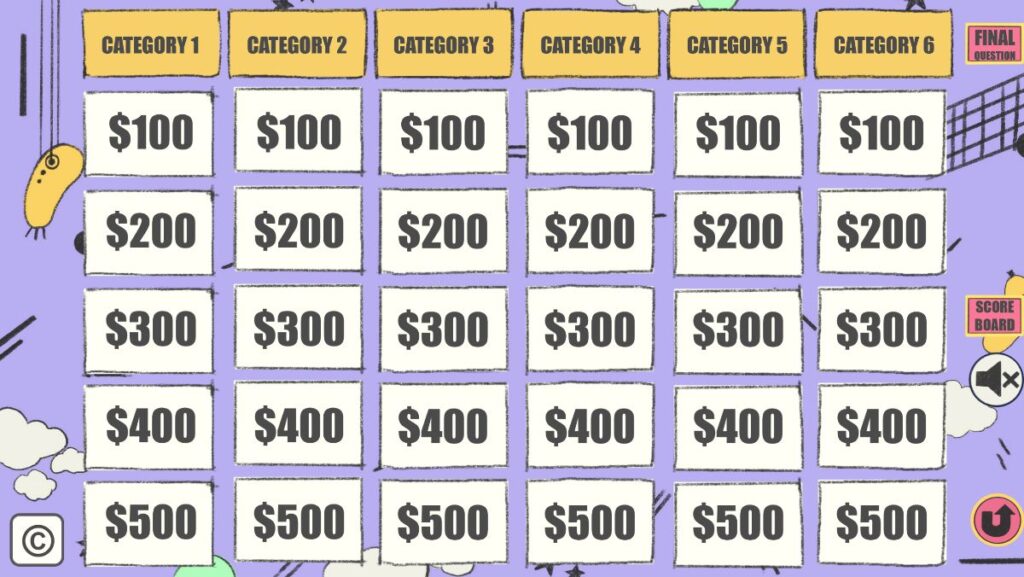Classroom Jeopardy Game Rules
Classroom Jeopardy is a fun way to learn in school. It’s like the TV show “Jeopardy,” but for classroom lessons. This game helps students review what they’ve learned and makes learning exciting. Here’s how to set it up and play, explained simply for teachers with students who are learning English.
The main goal of Classroom Jeopardy is to review what students have learned in a fun way. It’s not just about winning points. The game helps everyone remember their lessons better. It also teaches students to work together and think fast. In the end, the team with the most points wins, but all students learn more by playing. The game makes learning fun and helps students feel good about what they know.
Time Allocation
Allocate 30-45 minutes for the game, including setup and scoring.
The game should take about 30 to 45 minutes. This includes setting up, explaining, playing, and finishing up. The time might change depending on how many questions you have and how fast the game goes.
Materials Needed
- Jeopardy Board: Create a Jeopardy board with categories and points (e.g., 100 to 500).
- Questions and Answers: Prepare questions and answers for each category.
- Buzzer System: Use bells or other noise-makers for students to “buzz in.”
- Scoreboard: Keep track of team scores.
- Timer: Use a stopwatch or phone timer to limit response time.
First, you need a few things to play the game. Make a Jeopardy board on a whiteboard or chalkboard. Write down different subjects at the top and points below them. You also need questions and answers for each subject. For buzzing in, use bells or just let students raise their hands. Keep score on a piece of paper or another board. Use a clock or phone to time the answers.
Preparation

- Set Up the Board: Write categories at the top of the board and points below each.
- Divide Students: Form teams (2-4 students per team is good).
- Review Rules: Explain how to play, buzz in, and how points are awarded or deducted.
Get the game ready before starting. Put the board up with subjects and points. Make teams of students. Each team should have 2 to 4 students. Tell the students how to play. Explain how to buzz in and how points work.
How to Play the Game
To start playing Classroom Jeopardy, choose a team to go first. This team picks a subject and a point number from the board. Read the question for that choice. Teams buzz in when they know the answer. The first team to buzz in gets to answer. If their answer is right, they get the points. If it’s wrong, they lose those points, and other teams get a chance to answer. After a question is done, it’s the next team’s turn to pick. Keep playing like this until all questions are answered. Remember, students should wait until they are called on after buzzing in before they give their answer.
Rules of the Game
- Taking Turns: Teams take turns choosing a category and point value.
- Answering Questions: When a question is asked, the first team to buzz in gets to answer.
- Correct Answers: If correct, the team earns the points. If wrong, points are deducted, and other teams can buzz in.
- Final Jeopardy: End with a “Final Jeopardy” where teams wager points on a final question.
- Winning: The team with the most points at the end wins.
The rules are simple. Teams take turns choosing a subject and a point number. When you ask a question, the first team to buzz in can answer. If they’re right, they get points. If they’re wrong, they lose points. Other teams can try if the first team is wrong. The game ends with a “Final Jeopardy” question. The team with the most points at the end wins.
Extra Tips for Success
- Clarity: Use simple language for questions and answers to ensure understanding.
- Engagement: Encourage all team members to participate by rotating who chooses the category and who answers.
- Feedback: Provide correct answers and explanations for educational value.
- Variation: Adapt categories and questions to fit the lesson or subject area.
- Inclusivity: Ensure questions cater to various skill levels to keep all students engaged.
Make sure to use easy words for questions and answers. This helps everyone understand. Let different students pick subjects and answer questions so everyone plays. If someone answers wrong, tell them the right answer. This helps them learn. Change the game to make it work for your class. Some questions can be easy, and some can be hard. Make sure everyone feels happy and included.
Classroom Jeopardy is a great way to make learning fun. Follow these simple steps, and you’ll have a game that helps students review and enjoy their lessons.

